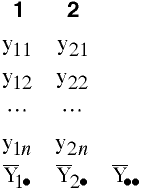
In between-subjects designs, responses from a given subject appear in only one group.
The variability of scores within each group reflects individual differences and is accounted for by the chance elements in sampling. This sampling variability is thus due to chance.
The variability of means between groups reflects both individual (chance) differences and differences due to the treatment.
Consider the following experiment:

Sources of Variability
Within-subjects designs are also appropriate for pretest-posttest type designs. With this design, subjects are observed prior to any treatment, then they receive a treatment, and finally they are observed at posttest. It is possible to extend this design to include a retention test at a later time. Designs of this type may also be called repeated-measures designs.
Within-subjects can also be used in certain situations that involve dependent observations. For example research involving husbands and wives, studies involving twins or regular siblings, or research using subjects matched on one or more variables.
In summary, within-subjects designs can be found in the following situations:
| Subject ID | Pre-test | Post-test | Follow up | means |
|---|---|---|---|---|
| 1 | Y11 | Y21 | Y31 | mean1 |
| 2 | Y12 | Y22 | Y32 | mean2 |
| 3 | Y13 | Y23 | Y33 | mean3 |
| ... | Y1... | Y2... | Y3... | mean... |
| n-1 | Y1n-1 | Y2n-1 | Y3n-1 | meann-1 |
| n | Y1n | Y2n | Y3n | meann |
| means | mean Y1 | mean Y2 | mean Y3 |
Intro Home Page
Phil Ender, 14Nov00